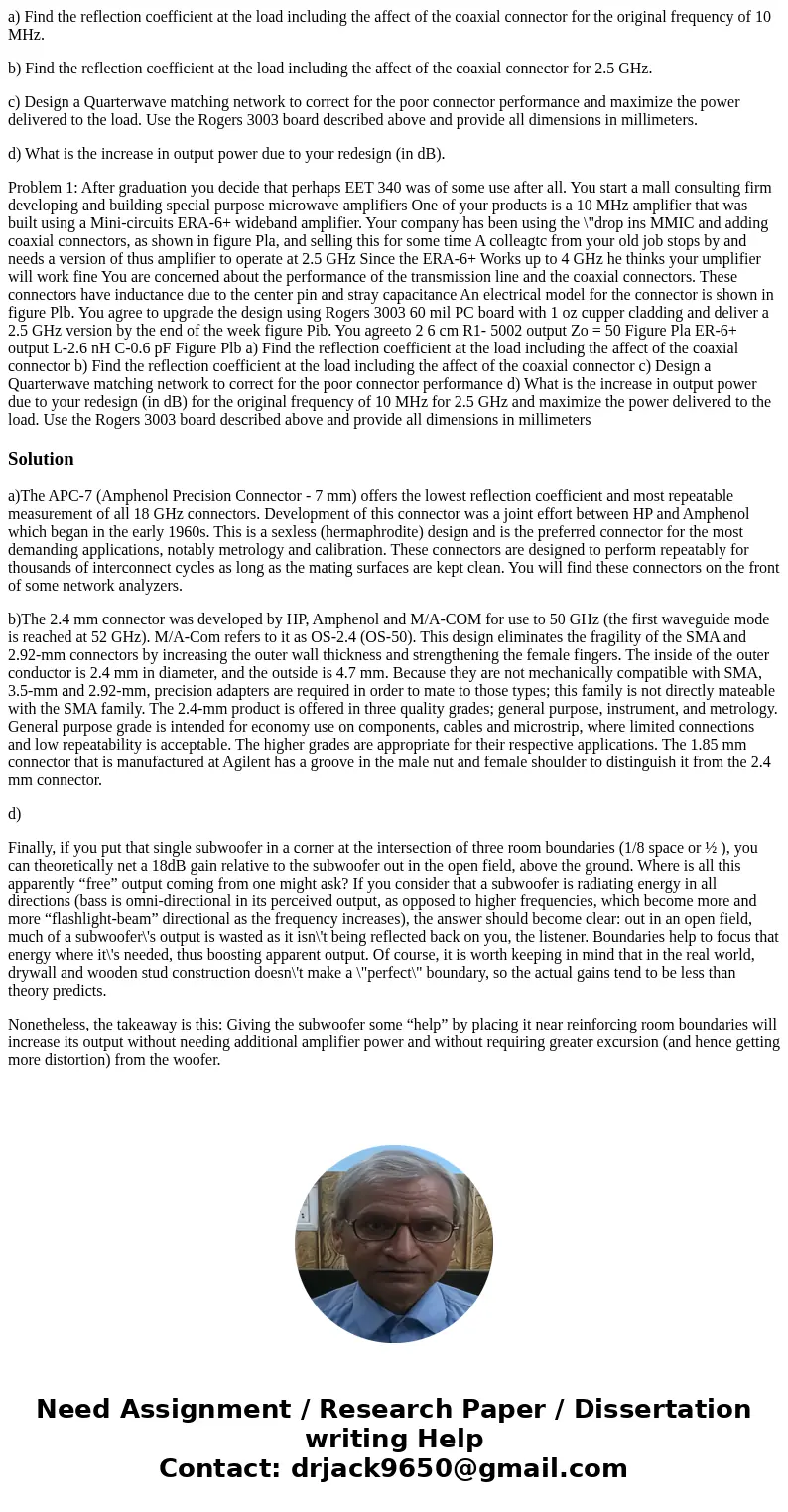a Find the reflection coefficient at the load including the
a) Find the reflection coefficient at the load including the affect of the coaxial connector for the original frequency of 10 MHz.
b) Find the reflection coefficient at the load including the affect of the coaxial connector for 2.5 GHz.
c) Design a Quarterwave matching network to correct for the poor connector performance and maximize the power delivered to the load. Use the Rogers 3003 board described above and provide all dimensions in millimeters.
d) What is the increase in output power due to your redesign (in dB).
Problem 1: After graduation you decide that perhaps EET 340 was of some use after all. You start a mall consulting firm developing and building special purpose microwave amplifiers One of your products is a 10 MHz amplifier that was built using a Mini-circuits ERA-6+ wideband amplifier. Your company has been using the \"drop ins MMIC and adding coaxial connectors, as shown in figure Pla, and selling this for some time A colleagtc from your old job stops by and needs a version of thus amplifier to operate at 2.5 GHz Since the ERA-6+ Works up to 4 GHz he thinks your umplifier will work fine You are concerned about the performance of the transmission line and the coaxial connectors. These connectors have inductance due to the center pin and stray capacitance An electrical model for the connector is shown in figure Plb. You agree to upgrade the design using Rogers 3003 60 mil PC board with 1 oz cupper cladding and deliver a 2.5 GHz version by the end of the week figure Pib. You agreeto 2 6 cm R1- 5002 output Zo = 50 Figure Pla ER-6+ output L-2.6 nH C-0.6 pF Figure Plb a) Find the reflection coefficient at the load including the affect of the coaxial connector b) Find the reflection coefficient at the load including the affect of the coaxial connector c) Design a Quarterwave matching network to correct for the poor connector performance d) What is the increase in output power due to your redesign (in dB) for the original frequency of 10 MHz for 2.5 GHz and maximize the power delivered to the load. Use the Rogers 3003 board described above and provide all dimensions in millimetersSolution
a)The APC-7 (Amphenol Precision Connector - 7 mm) offers the lowest reflection coefficient and most repeatable measurement of all 18 GHz connectors. Development of this connector was a joint effort between HP and Amphenol which began in the early 1960s. This is a sexless (hermaphrodite) design and is the preferred connector for the most demanding applications, notably metrology and calibration. These connectors are designed to perform repeatably for thousands of interconnect cycles as long as the mating surfaces are kept clean. You will find these connectors on the front of some network analyzers.
b)The 2.4 mm connector was developed by HP, Amphenol and M/A-COM for use to 50 GHz (the first waveguide mode is reached at 52 GHz). M/A-Com refers to it as OS-2.4 (OS-50). This design eliminates the fragility of the SMA and 2.92-mm connectors by increasing the outer wall thickness and strengthening the female fingers. The inside of the outer conductor is 2.4 mm in diameter, and the outside is 4.7 mm. Because they are not mechanically compatible with SMA, 3.5-mm and 2.92-mm, precision adapters are required in order to mate to those types; this family is not directly mateable with the SMA family. The 2.4-mm product is offered in three quality grades; general purpose, instrument, and metrology. General purpose grade is intended for economy use on components, cables and microstrip, where limited connections and low repeatability is acceptable. The higher grades are appropriate for their respective applications. The 1.85 mm connector that is manufactured at Agilent has a groove in the male nut and female shoulder to distinguish it from the 2.4 mm connector.
d)
Finally, if you put that single subwoofer in a corner at the intersection of three room boundaries (1/8 space or ½ ), you can theoretically net a 18dB gain relative to the subwoofer out in the open field, above the ground. Where is all this apparently “free” output coming from one might ask? If you consider that a subwoofer is radiating energy in all directions (bass is omni-directional in its perceived output, as opposed to higher frequencies, which become more and more “flashlight-beam” directional as the frequency increases), the answer should become clear: out in an open field, much of a subwoofer\'s output is wasted as it isn\'t being reflected back on you, the listener. Boundaries help to focus that energy where it\'s needed, thus boosting apparent output. Of course, it is worth keeping in mind that in the real world, drywall and wooden stud construction doesn\'t make a \"perfect\" boundary, so the actual gains tend to be less than theory predicts.
Nonetheless, the takeaway is this: Giving the subwoofer some “help” by placing it near reinforcing room boundaries will increase its output without needing additional amplifier power and without requiring greater excursion (and hence getting more distortion) from the woofer.

 Homework Sourse
Homework Sourse